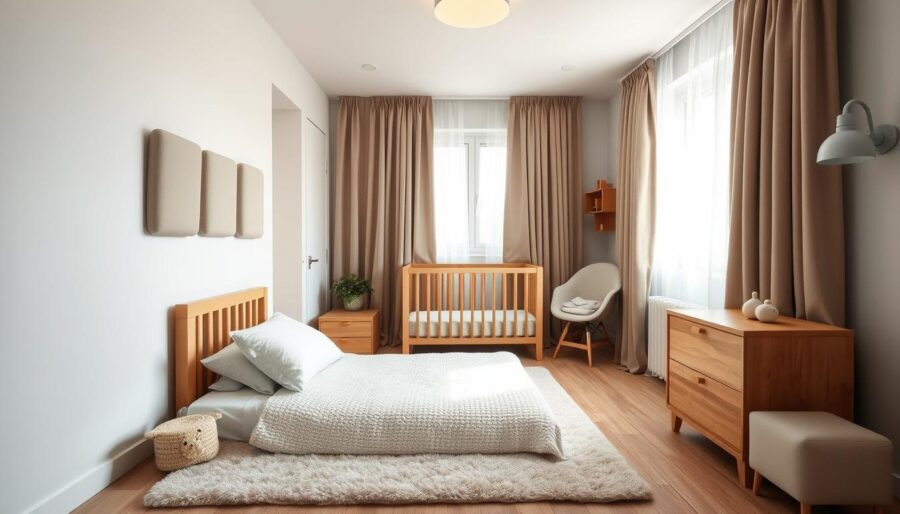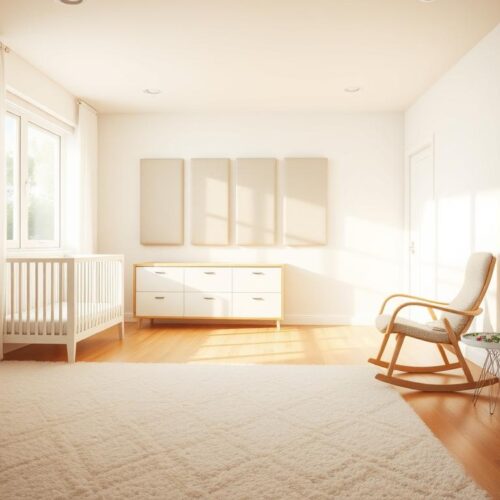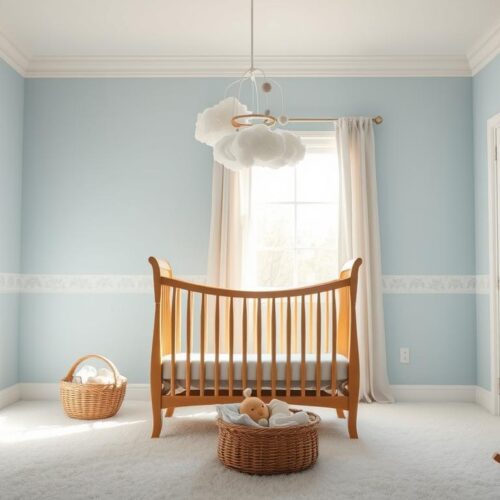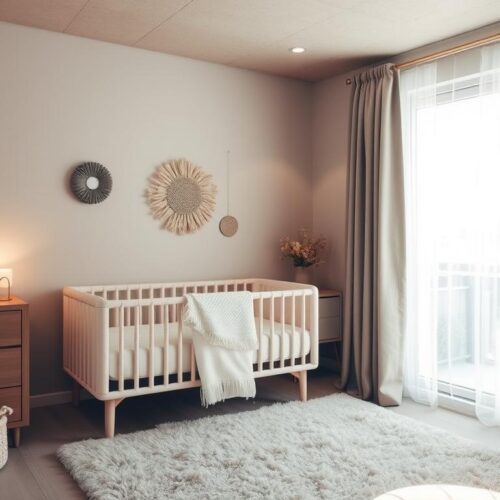Making a cozy spot for your baby means thinking about lots of things. And how sound moves in tight living spaces is one of them. As our homes in cities get more crowded, knowing how to manage noise in the nursery is key. This keeps your baby’s sleep nice and peaceful.
Sound really impacts how well your baby sleeps and feels. So, it’s crucial to find ways to cut down on noise in small spaces. If you’re a new parent or just want to make a better space for your kid, focusing on a quiet room is important. This will help make a calm and comfy spot for everyone.
Understanding the Importance of Acoustics for Your Baby
Your baby’s environment greatly affects their baby sleep patterns and happiness. Babies are sensitive to noise, which can mess up their sleep and stress them out. It’s important to know that the sounds in small homes can change how well your baby sleeps.
Creating a soundproof baby room is key. Studies show that good soundproofing reduces outside noise. This makes a quiet space for good sleep. By improving acoustics, you help your baby sleep better and be more emotionally stable.
When you focus on your baby’s sleeping area’s sound, you help their health and growth. A carefully crafted sound environment makes a peaceful place. Here, your baby can sleep well, feel rested, and be happy.
Why You Should Prioritize Sound Control in Baby Rooms
Making the baby’s room quiet is key for their growth and peace. It not only helps the baby but also gives parents a break. Keeping away loud noises makes a calm place that’s perfect for sleep.
Loud echoes can confuse babies, making them hard to calm down. Sound control steps lower these loud noises. This lets your baby sleep well without outside noise bothering them. It makes them feel safe and chill.
Keeping chats private is important in raising kids. Soundproofing the baby’s room means parents can talk freely, not worrying about waking the baby. This frees up space for better care, without outside noise cutting in.
In short, controlling sound makes a peaceful spot important for your baby’s health. Putting money into making the room quiet brings long-lasting good stuff. It creates a quiet home that puts your baby’s comfort first.
Acoustics in Small Apartments: Unique Challenges
Living in a small apartment presents its own set of sound issues. These can really impact your baby’s comfort and how well they sleep. Since there’s not much room, noises tend to be louder and bounce around more. This makes managing sound in tight spaces a tricky task.
Noise from neighbors is a big problem in small apartments. Sounds like footsteps, talking, and music can easily pass through walls and floors. This makes it hard to keep your home quiet. Echoes can also make even soft sounds seem louder, making noise an even bigger issue.
Trying to soundproof a small apartment can be tough because of the limited space. You might find regular soundproofing methods don’t work well. It can be hard to make a peaceful spot for your baby to sleep and relax well. It’s crucial to know how to deal with these sound challenges in small spaces.
Identifying Common Noise Sources
Making a quiet place for your baby in a small space is tough. Knowing the usual sources of noise helps a lot in keeping your baby’s room calm. It lets you act early to cut down noise.
Outside noise, from traffic, building work, or busy areas, is a big problem. It gets in through walls and windows, disturbing your baby’s sleep.
But noises inside are bothersome too. Things like:
- Appliances such as fridges and washers
- HVAC units that buzz or rattle
- Steps and voices from next door
Figuring out where noise comes from lets you find smart ways to lessen it. This way, you can keep the baby’s room peaceful and help your baby sleep better.
| Noise Source | Description | Impact on Baby |
|---|---|---|
| Traffic Noise | Sounds from cars, buses, or trains | Disturbs sleep, increases stress |
| Appliance Noise | Operational sounds from kitchen or laundry appliances | Interrupts peaceful playtime and rest |
| Neighbor Noise | Voices or activities from adjacent units | Creates anxiety and disrupts nap times |
| HVAC Noise | Hum or rattle from heating and cooling systems | Causes discomfort, potential awakening |
Effective Soundproofing Solutions for Baby Rooms
Making your baby’s room peaceful is key for their growth and good sleep. Adding soundproofing helps keep noise out in small spaces. Here’s how to make baby rooms quieter.
First, think about where you place furniture. Bookshelves and comfy items like couches and cushioned chairs help soak up sound. Put these things against walls you share with neighbors. This helps block noise. Heavy curtains also work well. Choose thick drapes that reach the floor to prevent outside noise and lessen echo inside.
It’s important to seal off spaces where sound comes in. Use weather stripping on doors and windows to stop noise. A solid door blocks sound better than a hollow one. This change can make the room quieter.
Acoustic panels are a flexible choice. You can put them on walls or ceilings to capture sound better. Pick styles that look good with your room while cutting down on noise. There are easy-to-use kits for parents too.
The table below quickly goes over these soundproofing tips:
| Soundproofing Solution | Description | Implementation Tips |
|---|---|---|
| Furniture Placement | Arrange items to absorb sound | Place shelves and soft furniture against walls |
| Heavy Curtains | Block outside noise | Use thick, floor-to-ceiling drapes |
| Sealing Doors/Windows | Prevent sound leaks | Apply weather stripping and consider solid core doors |
| Acoustic Panels | Absorb sound waves | Choose decorative panels for easy installation |
Creative Acoustic Treatment for Small Spaces
Designing a baby room in a small apartment is a chance to be creative with sound. You can make the sound better while keeping the room looking good. There are many ways to control noise and still have style.
Wall hangings are great for two reasons. They decorate the room and help quiet noises. Choosing wall hangings that are thick and textured helps soften sounds for your baby.
Soft things in the room are key for soaking up sound. Plush rugs, soft chairs, and padded ottomans make the room quiet and comfy. Picking these with both comfort and sound in mind makes the room better.
Making a room sound nice doesn’t have to be hard. Using furniture to block noise helps a lot. For instance, bookshelves can stop noise from traveling, making a calmer space for your baby.
In the end, getting creative in small spaces can give your baby a good sound environment. By adding stylish things that also handle sound, you can make a safe and calm place for your baby.
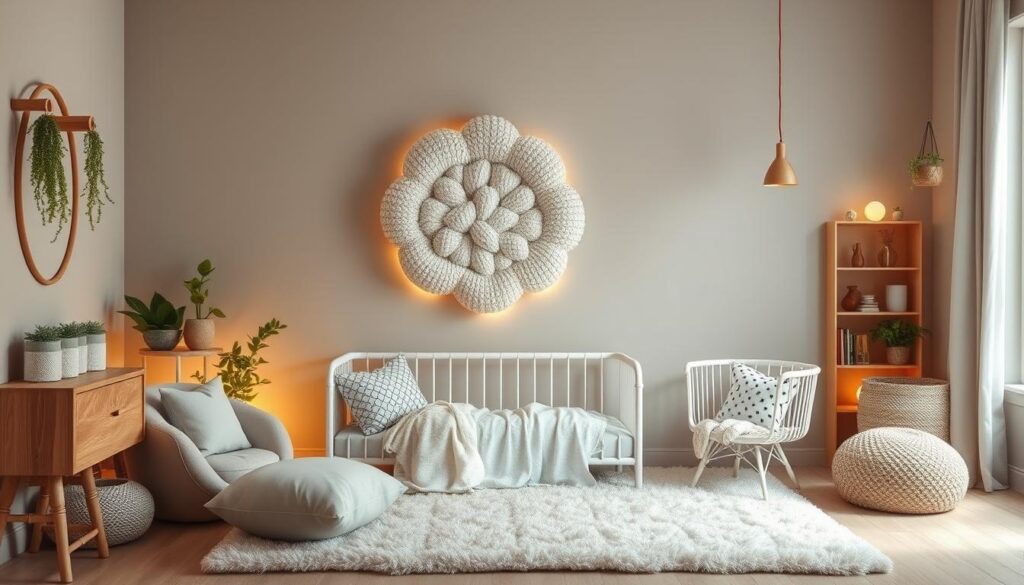
Noise Reduction Tips for Better Baby Room Acoustics
To create a calm space for your baby, start with noise-cutting tricks. Add soft things all around, like rugs and fluffy pillows. These items soak up sound, making your baby’s room quieter. You can also pick fabrics made to take in more sound, lowering noise even more.
Try using curtains that dampen sound. These curtains stop outside noise and keep the room’s temperature steady. This is very important for your baby’s comfort. Pick thick, heavy curtains for the best sound block.
A white noise machine can be a big help for peace and quiet. It mixes outside noises with a steady sound, helping your baby sleep better. You can easily set up this machine and adjust it as needed.
If you live in a small place, where you put your furniture can help lower noise. Place big pieces, like bookshelves, against walls you share with neighbors. This acts like extra soundproofing.
Using these tips, you can make the perfect space for your baby to sleep and play. Not only will these ideas make the baby’s room quieter, but they’ll also create a peaceful home for everyone.
Improving Sound Quality in Compact Rooms
In small rooms, certain tricks can make sound better. Arranging furniture the right way helps sounds move well. By placing things smartly, you can block noise and help air move around.
Think about using multi-functional furniture that looks good and helps with sound. This way, you use space wisely and cut down on noise. Soft stuff like rugs and couches soak up sound, making the room quieter.
The setup of these pieces is key for controlling sound well. Try different layouts to spread out materials that soak up sound. Adding soft things like curtains and bedding can also boost sound quality. This creates a calming spot for your baby.
Minimizing Echo and Reflection in Small Baby Rooms
In small baby rooms, it’s vital to minimize echo for a peaceful atmosphere. An echo can make the room seem noisy, not calm. Use soft things like rugs, curtains, and acoustic panels to stop echoes. These items help swallow sound, making the room sound better.
Try not to have too many flat, hard surfaces around. Pick furniture that has soft edges or different textures instead. This helps lessen noise reflections, making the room quieter.
Getting the balance right with sound treatments is key for a cozy space. Choosing the right materials carefully will help lower echo and reflection. This makes sure your baby can sleep in a calm, sound-friendly room.
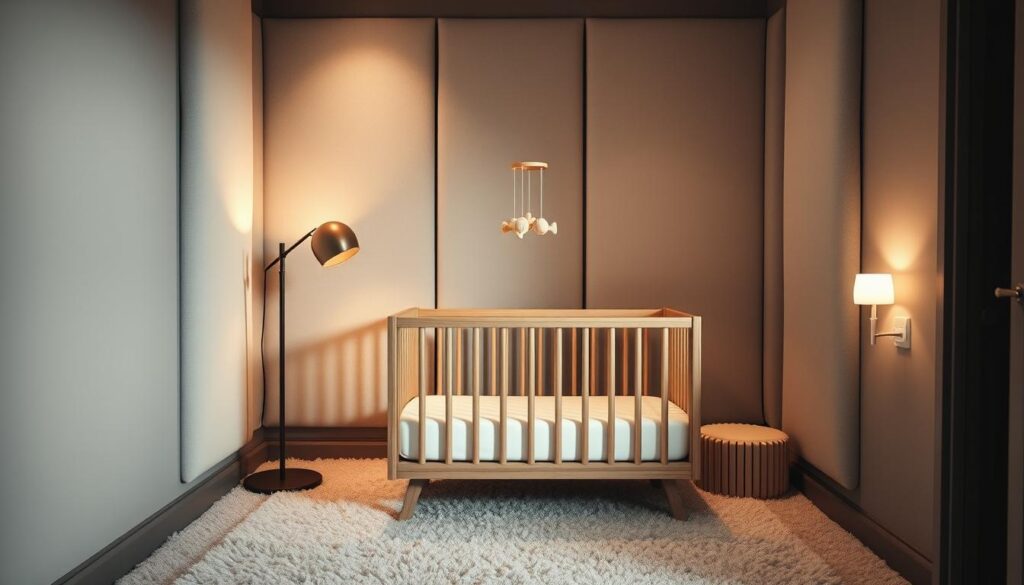
Conclusion
To wrap up, sound control is key for a peaceful baby room. This is even more important in small apartments where noise can quickly become too much. By using soundproofing, you can make a cozy and calm space for your baby.
Good acoustics in your baby’s room are crucial. They help your baby sleep better and support their health and growth. So, it’s important to include noise-reducing steps in your plans. This way, you build a better living space for your whole family.
The choices you make about your baby’s room sound matter a lot. A quiet room helps your baby’s mood and growth. By choosing the right soundproofing, you’re making a big investment in your child’s future happiness.

